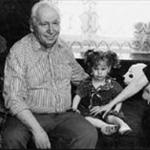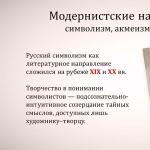I bring to your attention a presentation on the topic: The importance of walking for children. IN preschool age, walking plays an important role in promoting the health of a growing body. There is a place for games, creativity, and communication between children.
Download:
Preview:
To use presentation previews, create a Google account and log in to it: https://accounts.google.com
Slide captions:
Walk in kindergarten. Walking games
Every child is a little explorer; he discovers for himself with joy and surprise the world.
Children strive for active activity, and it is important not to let this desire fade away, to promote it further development. The more complete and varied the children's activities during the walk are organized, the more successful the children's development will be, the better the potential opportunities and children's creative manifestations will be realized.
The activities that are closest and most natural to children, such as play, communication with adults and peers, observation, and child labor, occupy a special place during the walk.
During a walk, it is necessary to integrate such educational areas as: “Physical Education”, “Health”, “Safety”, “Socialization”, “Cognition”, “Communication”, “Labor”.
Integration is possible in the process of mastering sensory standards when mastering the rules of safe behavior, speech skills, experience of communicating with children and adults, reflecting various subjects in outdoor games, forming the habit of alternating sedentary activities with active motor rest...
Purpose of the walk: – health promotion, fatigue prevention, physical and mental development children – restoration of the functional resources of the body reduced during activity.
Objectives of the walk: Physical development of children Optimization of motor activity Mental development of children Solving problems of moral education
Planning a walk 1. Providing active, meaningful, varied and interesting activities for children: games, work, observations. 2. Uniform alternation of calm and motor activities of children, proper distribution of physical activity throughout the walk. 3. The sequence and duration of different types of activities changes taking into account specific conditions: - time of year, - weather, - age of children - the nature of their previous activities. The content of evening walks is planned taking into account all the children’s previous activities.
Walk structure Observation. Motor activity: outdoor games, sport games, sport exercises. Individual work with children. Independent play activity.
Observation A large place is given to observations (pre-planned) of natural phenomena And social life. Observation can be carried out with a whole group of children, with subgroups, as well as with individual children. The teacher involves children in observations in order to develop attention and interest in nature and social phenomena. The surrounding life and nature provide an opportunity to organize interesting and varied observations. For example, you can pay attention to the clouds, their shape, color, and compare them with images known to children.
Physical activity The leading place during a walk is given to games, mainly outdoor games. They: - develop basic movements, - relieve mental stress, - educate moral qualities. During the walk we include outdoor games: 1-2 games of high mobility; 1-2 games of low and medium mobility; Games of children's choice.
An outdoor game can be played at the beginning of the walk if educational activities was associated with children sitting for long periods of time. If they go for a walk after a music or physical education lesson, then the game can be played in the middle of the walk or half an hour before it ends.
The choice of game depends on the time of year, weather, air temperature
The effectiveness of walks in a preschool institution is largely determined by an understanding of their significance, which is to: - satisfy the child’s natural biological need for movement; - ensure the development and training of all systems and functions of the child’s body through motor activity and physical activity specially organized for this age; -build skills in different types movements; -promote the development of the child’s motor qualities and abilities; -stimulate the functional capabilities of each child and activate children's independence; - create optimal conditions for the comprehensive development of children: activation mental activity, search for adequate forms of behavior, formation of positive emotional and moral-volitional manifestations of children.
Conclusion So, the process of raising children is continuous. Great potential opportunities for the comprehensive harmonious development of the child’s personality are inherent in the educational process -educational work with children on a walk. Here, like nowhere else, children are provided with unique conditions for all-round development; their needs for active movements, independent actions when getting to know the world around them, new vivid impressions, and free play with both natural materials and toys are fully satisfied. However, due to age characteristics, children themselves cannot use all the time of walking with maximum benefit for your development. An adult must pedagogically correctly guide their activities. In the process of daily outdoor games and physical exercises during walks, children’s motor experience expands and their existing skills in basic movements are improved; agility, speed, endurance develop; independence, activity, and positive relationships with peers are formed.
Organization of a walk in a preschool educational institution in accordance with the Federal State Educational Standard for Preschool Education Educator: Plotnikova N.P. G.A. Speransky wrote: “A day spent by a child without a walk is lost for his health.” Every child is a little explorer, he discovers the world around him with joy and surprise. Children strive for active activity, and it is important not to let this desire fade away and to promote its further development. The more complete and varied the children's activities during the walk are organized, the more successful the children's development will be, the better the potential opportunities and children's creative manifestations will be realized. Therefore, the activities that are closest and most natural to children, such as play, communication with adults and peers, experimentation, observation, and child labor, occupy a special place during the walk. Every child is a little explorer; he discovers the world around him with joy and surprise. Children strive for active activity, and it is important not to let this desire fade away and to promote its further development. The more complete and varied the children's activities during the walk are organized, the more successful the children's development will be, the better the potential opportunities and children's creative manifestations will be realized. Therefore, the activities that are closest and most natural to children, such as play, communication with adults and peers, experimentation, observation, and child labor, occupy a special place during the walk. Main objectives of the walk
- Develops mental abilities and observation skills.
- Provides an opportunity to introduce children to their hometown, its attractions, and the work of adults.
- Satisfies the child's natural biological need for movement.
- Children learn to overcome various obstacles, become agile, dexterous, courageous, and resilient.
- Children develop motor skills and abilities, strengthen the muscular system, and increase vitality.
- During the walk, problems of mental, moral, physical, labor and aesthetic education are solved. Thus, properly organized and thoughtful walks help to achieve the goals of the comprehensive development of children.
Development of physical qualities
Accumulation and enrichment of children’s motor experience
Preservation and strengthening of children’s physical and mental health
Solved through Solved through
Outdoor games
Development of basic movements
Objectives of the educational field “SOCIAL AND COMMUNICATIVE DEVELOPMENT”
- Development of children's play activities.
- Introduction to basic generally accepted norms and rules of relationships with peers and adults;
- Development of labor activity;
- Developing a value attitude towards one’s own work, the work of other people and its results;
Work assignments
Observations
Outdoor games.
Objectives of educational areas Objectives of educational areas "FCCM" and "FEMP"
- Development of cognitive-research and productive (constructive) activities;
- Formation of elementary mathematical concepts;
- Formation of a holistic picture of the world, broadening the horizons of children;
- outdoor games with children
- labor assignments
- introduction to adult labor
- observations
- experimenting with objects in the surrounding world
- targeted walks
- independent play activities They form one direction - COGNITIVE DEVELOPMENT
- Development of free communication with adults and children;
- Development of all components oral speech children (lexical side, grammatical structure speech, pronunciation side of speech; coherent speech – dialogical and monologue forms) in various forms and types of children's activities;
- Practical mastery of speech norms by pupils.
Observations
Independent play activity
Outdoor games.
Objectives of educational areas " Artistic and aesthetic development» 2 1. development of aesthetic perception, aesthetic emotions. 2.development of aesthetic and artistic and creative abilities. 3. Perception of music, fiction, folklore 4. Implementation of independent creative activity children Decided Decided
Observations
1.Perception of the world
nature (peer,
notice the beauty of nature.)
2.Aesthetic perception
social world
(human labor)
Independent play activity
Forms of training organization: 1. Design
(Laying on asphalt, sand, snow from natural materials (sticks, pebbles, plastic plugs, autumn leaves, fruits and other materials).
2. Artistic and visual activities (Drawing with a stick, on sand, snow.)
3. Music. (Development of creativity:
song, music and play, dance)
When organizing a walk, you should observe a reasonable alternation of joint activities with the teacher and independent activities of children, specially organized educational situations and free play and practical activities of the children’s choice, physical and mental stress, active activity and relaxation. When organizing a walk, you should observe a reasonable alternation of joint activities with the teacher and independent activities of children, specially organized educational situations and free play and practical activities of the children’s choice, physical and mental stress, active activity and relaxation. Structural Components walks Structural components of a walk
Various observations.
Basic movements and outdoor games.
Labor activity.
Independent play activities of children.
Each of the required components of the walk takes time from 7 to 15 minutes V younger age And from 20 to 25 minutes in older children and is carried out against the background of independent activity of children.
Observations are the main method of learning. Observations are the main method of learning. Observations in younger group should take no more than 7-10 minutes and be bright and interesting; at older ages, observations should range from 15 to 25 minutes. Objects of observation
Wildlife: plants and animals
Inanimate nature: seasonal changes and various natural phenomena (rain, snow, flowing streams)
Adult labor
Types of observation Types of observation
Short-term
organized to formulate information about the properties and qualities of an object or phenomenon
Long-term
are organized to accumulate knowledge about the growth and development of plants and animals, and about seasonal changes in nature.
When organizing observations, the teacher must always follow this sequence: When organizing observations, the teacher must always follow this sequence:
- facts are established;
- connections are formed between parts of the object;
- children's ideas are accumulating;
- comparisons are made;
- conclusions are drawn and connections are made between the observations being carried out now and those carried out previously.
- Children's motor experience expands
- Improves skills in basic movements
- Physical qualities develop
- Independence and activity are formed
- Positive relationships with peers
Younger age – 6-10 minutes
Older age -
10-15 minutes
Game Game
Older age
Relay races, sports games, and games with elements of competition are held.
Middle group The teacher distributes roles among the children (the role of the driver is performed by a child who can cope with this task).
Work assignments. Work assignments. Forms of labor organizationIndividual work assignments are applied in all age groups of kindergarten.
Teamwork
makes it possible to develop labor skills and abilities simultaneously in all children in the group. During collective work, the ability to accept a common goal of work, coordinate one’s actions, and plan work together is formed.
Group work
Independent play activity. Independent play activity. During independent play activities, children reflect the impressions received during educational activities, excursions, Everyday life, acquire knowledge about the work of adults. This happens in the process of role-playing games. Walks will be joyful, interesting, educational and will achieve their goal, provided that the teacher is able to interest and enrich the children’s knowledge. Preschoolers look at the world around them with great interest, but they don’t see everything, sometimes they don’t even notice the main thing. And if the teacher, who wonders with them, teaches not only to look, but also to see, the children will want to learn more. Walks will be joyful, interesting, educational and will achieve their goal, provided that the teacher is able to interest and enrich the children’s knowledge. Preschoolers look at the world around them with great interest, but they don’t see everything, sometimes they don’t even notice the main thing. And if the teacher, who wonders with them, teaches not only to look, but also to see, the children will want to learn more. THANK YOU for your attention!
By clicking on the "Download archive" button, you will download the file you need completely free of charge.
Before downloading this file, remember those good essays, tests, term papers, theses, articles and other documents that lie unclaimed on your computer. This is your work, it should participate in the development of society and benefit people. Find these works and submit them to the knowledge base.
We and all students, graduate students, young scientists who use the knowledge base in their studies and work will be very grateful to you.
To download an archive with a document, enter a five-digit number in the field below and click the "Download archive" button
Similar documents
Goals, objectives and types of walks in kindergarten. Basic requirements for the sanitary condition of the site, time spent in the fresh air, as well as for organizing preschoolers for a walk. Recommendations for parents on hardening preschool children.
presentation, added 11/13/2013
Assessment of the educational significance of the daily routine in kindergarten. Considering a walk in nature as the most accessible means of hardening a child’s body. Studying the basics of nurturing love and respect for the natural environment.
presentation, added 11/01/2015
Kindergarten daily routine. Organization of a walk in preschool educational institution. Psychological characteristics young children. Organization and conduct of observations. General principles organizing motor activity of children during a walk.
course work, added 05/27/2014
Walks and their importance in the environmental education of preschool children, features of their organization at different times of the year. Conducting targeted walks and hikes, their tasks and functions in introducing the child to the natural world and developing a sense of responsibility for it.
test, added 08/02/2009
Using walking to develop the movements of preschool children. Basic principles of organizing motor activity of children during a walk. Methodology for guiding the motor activity of children with different levels of DA. Walking notes.
test, added 03/11/2010
course work, added 11/18/2014
Educational and health-improving significance of children taking walks in the fresh air in a kindergarten group, features physical education classes on a walk. Methodology for conducting, selecting and alternating physical exercises and games with older children.
test, added 09.29.2011
To view the presentation with pictures, design and slides, download its file and open it in PowerPoint on your computer.
Text content of presentation slides:“Organization and conduct of a walk in a kindergarten” Work performed by: Elena Aleksandrovna Smetkina The purpose of the walk is to improve health, prevent fatigue, physical and mental development of children, restore the functional resources of the body reduced during activity. A walk is a very important routine moment in the life of children in kindergarten; it has a hardening effect on the body in natural conditions; it helps to increase the level of physical fitness children of preschool age to optimize the motor activity of children to promote cognitive-speech, artistic-aesthetic, social and personal development of children. Objectives of the walk: Requirements for the content of walks on the preschool site The walk should consist of the following structural elements Observation Work assignments Independent activity of children Motor activity: outdoor activities, sports games, sports exercises Individual work in various areas of development of pupils Observations Organization of observations: When planning observations, the teacher thinks through: equipment and materials used during the observation, placement of children; techniques for attracting children's attention to observation (surprise moment, riddles, setting a cognitive task, problem situation); techniques for activating mental activity (search questions, actions, comparisons, using childhood experience). Observations Organization of physical activity The leading place during the walk is given to games, mainly active ones. They develop basic movements, relieve mental stress, and cultivate moral qualities. During the walk we include outdoor games: 2-3 games of high mobility; 2-3 games of low and medium mobility; Games of the children’s choice. An outdoor game can be played at the beginning of the walk, if the educational the activity was associated with children sitting for a long time. If they go for a walk after a music or physical education lesson, then the game can be played in the middle of the walk or half an hour before it ends. Motor activity Independent physical activity. Organization of individual work Labor assignments. All these parts of the structure are required during a walk; they make it more eventful and interesting. Pupils on a walk find themselves in a world that is already familiar, but changes depending on the seasons, climatic conditions. And our goal during the walk is to solve several problems at once - to develop not only physical skills, but also the moral and emotional interest of children in the walk. During walks, it is necessary to develop detailed knowledge about various objects (it’s raining, the cat washes itself with its paw), navigate the world around us (let’s go to the slide, to the table, etc.), develop the ability to listen to an adult and perform movements depending on his requirements. Thank you for your attention !
Attached files
To use presentation previews, create a Google account and log in to it: https://accounts.google.com
Slide captions:
Walks for young children Walks for young children Teacher Elena Pavlovna Verbnyakova
The most important task is to preserve and strengthen the health of children. Children's stay in the fresh air has great importance for physical development. Walking is the first and most accessible means of hardening a child’s body. It helps to increase its endurance and resistance to adverse effects. external environment, especially to colds. Thus, properly organized and thoughtful walks help to achieve the goals of the comprehensive development of children.
A properly organized walk helps children not only have fun, but also usefully spend time in the fresh air. In winter, walks are carried out at air temperatures down to -15 degrees; clothing during the cold period should consist of 3-4 layers and not restrict the child’s movement. A teacher and a junior teacher help children get dressed. Children are taken to the site in groups; the entire group is not allowed to go for a walk at the same time.
Components of the walk: 1. Observation; 2. Labor activity; 3. Game activity (p/i, m/i, i/sr.akt.); 4. Individual work; 5. Independent activity of children; 6. Artistic and visual activities; 7. Orientation in space.
Observation, what we include here: observation of natural phenomena, which allows them to form holistic orientations towards nature and social phenomena. observations of weather changes, transport, animals, trees, birds, the work of adults, flora, for water, for the sky, for the wind, for the clothes of adults, peers, for insects, etc.;
Labor activity. We instill the necessary labor skills and abilities to keep the veranda clean, feed the birds, not throw sand around the site, and collect interesting natural material. It is planned to care for snow buildings on the site in winter (removing snow from the figures)
Game activity. The choice of game depends on the time of year, weather, air temperature, on the previous lesson, on the condition of the children, their desires, on the time of walks; We play outdoor games that provide the child with movement.
Individual work is aimed not only at improving physical qualities, but also at developing mental processes and consolidating material. Children's independent activities during walks take place under the supervision of a teacher. This is necessary so that children do not overheat or become hypothermic, and games should be varied in content and physical activity. When organizing independent activities of children, you need to take them into account individual characteristics, degree of mobility, in accordance with weather conditions.
Artistic and visual activities. This is a favorite activity for children on a walk; they really like to draw lines, circles, as well as different shapes of animals and birds in the snow with sticks in the cold season, and drawing with crayons in the warm season. Orientation in space. This is a walk around the kindergarten site, especially when there are a lot of interesting, bright figures on the territory.
Conclusion: daily mandatory walks with children not only contribute to general health, but also comprehensively develop our kids.
On the topic: methodological developments, presentations and notes
organization of walks and hikes with preschool children
This material presents a booklet for kindergarten teachers with brief description methods for organizing walks and hikes with preschool children...
Organization of walks with children of senior preschool age
An important element educational process preschool are walks with children. Traditionally, the walk includes organizing observations of natural phenomena (growing...
Forms of organizing the physical development of children of early preschool age
Efficiency of solving problems of directed use physical culture in early and preschool age depends on the organization of an appropriate motor regime. Forms of organization of physical re...




